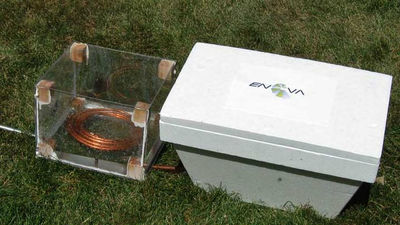What is the reason why the motor developed by a 17-year-old boy is attracting attention as `` it may change the future of electric vehicles ''?

by Society for Science
A 17-year-old boy living in the United States developed a motor with a new mechanism, and won the highest award and $ 75,000 (about 1000 dollars) at the
This 17-Year-Old Designed a Motor That Could Potentially Transform the Electric Car Industry | Innovation| Smithsonian Magazine
https://www.smithsonianmag.com/innovation/this-17-year-old-designed-a-motor-that-could-potentially-transform-the-electric-car-industry-180980550/
Robert Sanson, a 17-year-old living in Florida, USA, is an inventor who has worked on various engineering projects such as hands applying animatronics and go-karts exceeding 100 km / h. After watching a video explaining the pros and cons of electric cars, Sanson learned that electric car motors are problematic in terms of sustainability.
Most electric vehicle motors require permanent magnets made from the rare earth elements neodymium and dysprosium . However, since mining rare earths is costly both financially and environmentally, there are concerns about a rare earth supply shortage as electric vehicles become more popular.
Sanson, who was interested in the sustainability of electric vehicle motors, focused on synchronous reluctance motors that do not use permanent magnets that require rare earths. Synchronous reluctance motors are used in pumps and fans, but they are not powerful enough to power electric vehicles in terms of torque and efficiency.
Therefore, Mr. Sanson began to consider how to improve the performance of the synchronous reluctance motor, and spent a year manufacturing various prototypes. Prototypes using plastic, copper wire, steel rotor, etc. as materials were manufactured using a 3D printer, and various meters were used to measure the force. 'I was originally interested in electric motors,' said Sanson. 'I wanted to work on that sustainability issue and design and try another motor.'
The following ISEF video introduces the motor that Sanson developed and how he speaks.
Meet Robert Sansone, winner of the 2022 George D Yancopoulos Innovator Award Regeneron ISEF-YouTube
This boy is Sanson.

This is the prototype of the new synchronous reluctance motor.

Synchronous reluctance motors work by energizing a stator to create a magnetic field that spins an air-gapped steel rotor. Mr. Sanson said that he devised a method of increasing torque by incorporating another magnetic field into the motor, but since he is aiming to patent the technology in the future, the detailed mechanism is not disclosed.

Mr. Sanson won the best prize at ISEF for the development of a new synchronous reluctance motor. Sanson, who wants to go on to the Massachusetts Institute of Technology, plans to use the prize money of $ 75,000 for tuition.

Since Sanson did not have the resources to manufacture advanced motors, he used a 3D printer to manufacture a small prototype. ``I didn't have a mentor to help me, so every time the motor failed, I had to do a lot of research and troubleshoot what went wrong,'' Sanson said, actually 15. He said that he was finally able to manufacture a practical motor with the first prototype.
The new synchronous reluctance motor delivers 39% more torque and 31% more efficiency at 300 revolutions per minute (RPM), and 37% more efficiency at 750 RPM. It seems that the plastic prototype melted when the number of rotations was further increased, but it was confirmed that the torque and efficiency were improved by the design change.
'He's definitely looking at things in the right direction,' said Heath Hoffman, a professor of electrical and computer engineering at the University of Michigan. 'This motor could be the next big innovation.' On the other hand, he also points out that although many researchers other than Mr. Sanson are working on research for the rest of their lives, the possibility that inventions will actually change the world is very small.
At the time of writing the article, Sanson is working on calculations and 3D modeling for the 16th prototype production, and next aims to manufacture with more robust materials. “Rare-earth materials in existing electric motors are a major obstacle to the sustainability of electric vehicles.” It's a dream,' Sanson said.
Related Posts:







